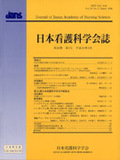Japanese
English
- 販売していません
- Abstract 文献概要
- 参考文献 Reference
- サイト内被引用 Cited by
要旨
本研究は,身体の回復過程を体験した学童が自分の病状を「だいじょうぶ」ととらえる構造を明らかにする目的で,グランデッドセオリーを用いて行った.結果は,子どもが「だいじょうぶ」ととらえるようになっていくプロセスの構造が明らかとなり,4つのコアカテゴリー『何をされるんだろう』,『自分を守るコツをつかむ』,『身体と仲良し』,『再チャレンジ』からなるプロセスと,そのプロセスに絡む1つのカテゴリー『大人の力も必要』が見出された.このプロセスは,子どもが日常生活から逸脱した体験に脅威を感じるが,やがて苦痛体験の蓄積から苦痛のパターンに気づき,パターンを基に独自の解釈や予測を行うようになり,戦略を見出し,身体の違和感も日常感覚に取り込めるようになる.しかし,克服していない新たな課題が発生した時は,コントロール力をいったん失い再構成するという段階を踏む構造があった.そして,この構造より,構造に内包する子どもの「だいじょうぶ」を抽出し,定義した.
Abstract
I studied how school-age children perceived their physical condition after having recovered from an illness using the grounded theory.
I clarified the structure of the process how they perceived the change of their physical conditions during the time of a recovery and finally they could get a feeling of “all right”(Daijoubu).
I found 4 core categories that constituted the process, i.e., “what will be done to me?”, “acquiring the skill of protecting oneself”,“making friends with one's own body”,and “challenging again”, and a category related to this process, i.e., “adults’help is also necessary”. In this process, children were afraid of new experiences outside of their daily life, but they gradually noticed patterns of pain from the accumulation of painful experiences. They also began to interpret or expect pain on the basis of the patterns. As well they found a strategy to cope with it, and became able to incorporate physical discomfort into their daily life. However, if new problems that they have not encountered appear, they temporarily lose their control ability but eventually regain it. I extracted the sense of recovery perceived by these children from this structure and defined it as ‘Daijoubu’.
Copyright © 2006, Japan Academy of Nursing Science. All rights reserved.


